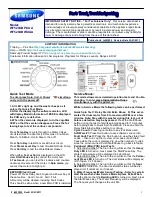
5
STACKED WASHER/DRYER SAFETY
n
Clean dryer lint screen before or after
each load.
n
Do not use this dryer without the lint screen
in place.
n
Under certain conditions, hydrogen gas
may be produced in a hot water system that
has not been used for 2 weeks or more.
HYDROGEN GAS IS EXPLOSIVE. If the hot
water system has not been used for such a
period, before using the washer, turn on all
hot water faucets and let the water flow from
each for several minutes. This will release
any accumulated hydrogen gas. As the gas
is flammable, do not smoke or use an open
flame during this time.
n
Do not repair or replace any part of the
washer/dryer or attempt any servicing unless
specifically recommended in this Use and
Care Guide or in published user-repair
instructions that you understand and have
the skills to carry out. If the supply cord
is damaged, it must be replaced by the
manufacturer, its service agent, or similarly
qualified persons in order to avoid a hazard.
n
Fabric softeners, or similar products, should
be used as specified by the fabric softener
instructions.
n
Items such as foam rubber (latex foam),
shower caps, waterproof textiles, rubber-
backed articles, and clothes or pillows fitted
with foam rubber pads should not be dried
in the tumble dryer.
n
The final part of a tumble dryer cycle occurs
without heat (cool-down cycle) to ensure
that the articles are left at a temperature that
ensures that the items will not be damaged.
n
WARNING:
Never stop a tumble dryer
before the end of the drying cycle unless
all items are quickly removed and spread out
so that the heat is dissipated. (Avoids risk of
spontaneous combustion).
n
WARNING:
The appliance must not be
supplied through an external switching
device, such as a timer, or connected to a
circuit that is regularly switched on and off
by a utility.
n
In case of electrical supply failure, remove
the load quickly and spread it out to avoid
risk of spontaneous combustion.
SAVE THESE INSTRUCTIONS
n
Do not dry unwashed items in the dryer.
n
Do not use this dryer if industrial chemicals
have been used for cleaning. The possible
presence of residual quantities of aggressive
or decomposed chemicals in the load may
produce damage to the dryer and harmful
fumes.
n
Do not allow children to play on or in
the washer/dryer. Close supervision of
children is necessary when the washer/
dryer is used near children. Cleaning and
user maintenance shall not be made by
children without supervision. Children of less
than 3 years should be kept away unless
continuously supervised.
n
This appliance is intended, but not limited,
to be used in public areas.
n
This washer/dryer is not intended for use by
persons (including children) with reduced
physical, sensory, or mental capabilities, or
lack of experience or knowledge, unless they
have been given supervision or instruction
concerning use of the dryer by a person
responsible for their safety.
n
Before the washer/dryer is removed from
service or discarded, remove the doors to
the washer/dryer compartments.
n
Do not reach into the washer/dryer if the tub,
agitator, or drum is moving.
n
Opening the dryer door will stop the function
of the dryer.
n
When loading or re-loading the dryer,
avoid touching hot metal parts of the
drum (burn risk).
n
Remove all objects from pockets such as
lighters and matches.
n
The appliance must be disconnected from
its power source during service and when
replacing parts.
n
If drum rotation is blocked due to trapped
textiles, disconnect the dryer from the
electrical supply before gently removing
the blockage.
n
If the dryer is not heating, or appears to be
defective or damaged, do not use it. Contact
the owner.
n
Do not install or store the washer/dryer
where it will be exposed to the weather.
n
Do not tamper with controls.






































